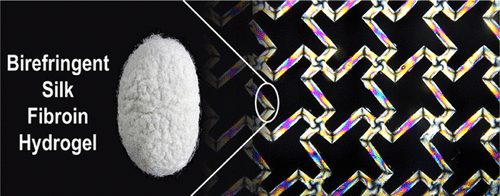当前位置:
X-MOL 学术
›
Biomacromolecules
›
论文详情
Our official English website, www.x-mol.net, welcomes your
feedback! (Note: you will need to create a separate account there.)
Birefringent Silk Fibroin Hydrogel Constructed via Binary Solvent-Exchange-Induced Self-Assembly
Biomacromolecules ( IF 5.5 ) Pub Date : 2021-03-01 , DOI: 10.1021/acs.biomac.1c00065 Ting Shu 1 , Ke Zheng 1, 2 , Zhizhou Zhang 3 , Jing Ren 1 , Zhengjun Wang 1 , Ying Pei 4 , Jingjie Yeo 5 , Grace X Gu 3 , Shengjie Ling 1
Biomacromolecules ( IF 5.5 ) Pub Date : 2021-03-01 , DOI: 10.1021/acs.biomac.1c00065 Ting Shu 1 , Ke Zheng 1, 2 , Zhizhou Zhang 3 , Jing Ren 1 , Zhengjun Wang 1 , Ying Pei 4 , Jingjie Yeo 5 , Grace X Gu 3 , Shengjie Ling 1
Affiliation

|
Birefringent hydrogels have a strong potential for applications in biomedicine and optics as they can modulate the optical and mechanical anisotropy in confined two-dimensional geometries. However, production of birefringent hydrogels with hierarchical structures, mechanical properties, and biorelated behavior that are analogous to biological tissues is still challenging. Starting from the silk fibroin (SF)-ionic liquid solution system, this study aimed to rationally design a “binary solvent-exchange-induced self-assembly (BSEISA)” strategy to produce birefringent SF hydrogels (SFHs). In this method, the conformational transition rate of SF can be effectively controlled by the exchange rate of the binary solvents. Therefore, this method provides the possibility of controlling the conformation and orientation of SF. Molecular simulations confirmed that methanol is more effective in driving β-sheet formation than other often used solvents, such as formic acid and water. The formed β-sheets act as the physical cross-links that connect disparate protein chains, thereby forming continuous and stable three-dimensional (3D) hydrogel networks. The resultant BSEISA-SFHs are transparent and birefringent with mechanical characteristics similar to those of soft biological tissues, such as lens and cartilage. Interestingly, our results revealed that the evolution of experimental birefringent fringes perfectly matched the changes in stress distribution predicted using finite element analysis. Owing to the unique birefringence of BSEISA-SFHs, together with the advantages in mechanical performance, these hydrogels are anticipated to act as good tissue surrogates for understanding the mechanical response of biological tissues.
中文翻译:

通过二元溶剂交换诱导的自组装构建双折射丝素蛋白水凝胶
双折射水凝胶在生物医学和光学领域具有广阔的应用前景,因为它们可以在有限的二维几何结构中调节光学和机械各向异性。然而,具有类似于生物组织的分级结构,机械性能和生物相关行为的双折射水凝胶的生产仍然具有挑战性。从丝素蛋白(SF)离子液体溶液系统开始,本研究旨在合理设计“二元溶剂交换诱导的自组装(BSEISA)”策略以生产双折射SF水凝胶(SFH)。在该方法中,可以通过二元溶剂的交换速率有效地控制SF的构象转变速率。因此,该方法提供了控制SF的构象和取向的可能性。分子模拟证实,甲醇比其他常用溶剂(例如甲酸和水)更能有效地促进β-折叠的形成。形成的β-折叠充当连接不同蛋白质链的物理交联键,从而形成连续且稳定的三维(3D)水凝胶网络。所得的BSEISA-SFH是透明的和双折射的,其机械特性类似于软生物组织(如晶状体和软骨)的机械特性。有趣的是,我们的结果表明,实验性双折射条纹的演化与有限元分析预测的应力分布变化完全匹配。由于BSEISA-SFH具有独特的双折射,以及机械性能方面的优势,
更新日期:2021-05-10
中文翻译:

通过二元溶剂交换诱导的自组装构建双折射丝素蛋白水凝胶
双折射水凝胶在生物医学和光学领域具有广阔的应用前景,因为它们可以在有限的二维几何结构中调节光学和机械各向异性。然而,具有类似于生物组织的分级结构,机械性能和生物相关行为的双折射水凝胶的生产仍然具有挑战性。从丝素蛋白(SF)离子液体溶液系统开始,本研究旨在合理设计“二元溶剂交换诱导的自组装(BSEISA)”策略以生产双折射SF水凝胶(SFH)。在该方法中,可以通过二元溶剂的交换速率有效地控制SF的构象转变速率。因此,该方法提供了控制SF的构象和取向的可能性。分子模拟证实,甲醇比其他常用溶剂(例如甲酸和水)更能有效地促进β-折叠的形成。形成的β-折叠充当连接不同蛋白质链的物理交联键,从而形成连续且稳定的三维(3D)水凝胶网络。所得的BSEISA-SFH是透明的和双折射的,其机械特性类似于软生物组织(如晶状体和软骨)的机械特性。有趣的是,我们的结果表明,实验性双折射条纹的演化与有限元分析预测的应力分布变化完全匹配。由于BSEISA-SFH具有独特的双折射,以及机械性能方面的优势,

































 京公网安备 11010802027423号
京公网安备 11010802027423号